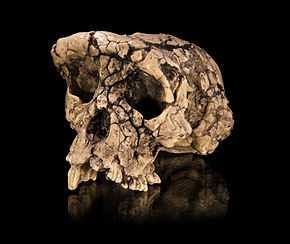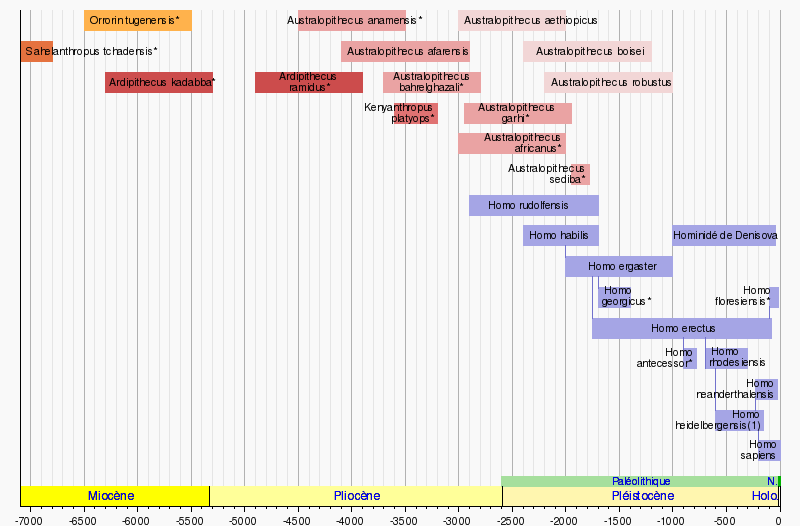Hominina
|
|
Cet article est une ébauche concernant les primates. Vous pouvez partager vos connaissances en l’améliorant (comment ?) selon les recommandations du projet correspondant.
|

Sous-tribu
Hominina
Goodman et al., 1990
La sous-tribu des Hominines (Hominina en latin scientifique) est la lignée des hominidés à laquelle appartient le genre humain actuel Homo et des espèces disparues, comme les australopithèques[1]. Elle regroupe les hominidés non arboricoles (bipèdes ou contribuant à l'émergence de la bipédie) et correspond à ce que l'on nomme communément les hominines (terme sans valeur taxinomique). Cette dénomination d'« hominine » a vocation à remplacer le terme d'« hominidé » en paléoanthropologie.
Attention :
- le terme Homininé, avec un é final, est le nom français pour la sous-famille des Homininae (et est orthographié « hominine » en anglais) ;
- le terme Hominine, avec un e final, est le nom français pour la sous-tribu des Hominina (et est orthographié « hominina » ou « homininan » en anglais).
Liste des genres
- Ardipithecusâ€
- Australopithecusâ€
- Homo (comprenant les humains actuels)
- Kenyanthropus*â€
- Orrorin*â€
- Ouranopithecus*â€
- Paranthropusâ€
- Sahelanthropus*â€
Légende : * discuté, †éteint
Cladogramme
- Hominoidea
- Hylobatidae (gibbon)
- Hominidae
- Ponginae Pongo (orang-outan)
- Homininae
- Gorillini Gorilla (gorille)
- Hominini
- Panina Pan (chimpanzé, bonobo)
- Hominina Australopithecus†et Homo (humain actuel)
Groupe frère
- Panina (Panines)
Liste des hominines
En l'état de nos connaissances, la liste des hominines, du plus ancien au plus récent, est la suivante :
- Sahelanthropus tchadensis > -7 millions d'années, espèce à laquelle appartient le fossile surnommé Toumaï
- Orrorin tugenensis > -6 millions d'années
- Ardipithecus kadabba Ramidus > -5,8 à -5,2 millions d'années
- Ardipithecus ramidus > -5,8 à -4,5 millions d'années
- Kenyanthropus platyops > -3,5 à -3,2 millions d'années
- Australopithèques graciles
- Australopithecus anamensis > -4,2 à -3,8 millions d'années
- Australopithecus afarensis > -4,1 à -3 millions d'années, espèce à laquelle appartient le fossile surnommé Lucy
- Australopithecus bahrelghazali -3,5 à - 3 millions d'années, espèce à laquelle appartient le fossile surnommé Abel
- Australopithecus africanus > -3,5 à -2,5 millions d'années
- Australopithecus garhi > -2,6 millions d'années
- Paranthropes ou australopithèques robustes
- Australopithecus aethiopicus > -2,7 à -2,3 millions d'années
- Australopithecus boisei > -2,4 à -1,2 million d'années
- Australopithecus robustus > -1,8 à -1,5 million d'années
- Représentants du genre Homo
- Homo rudolfensis > -2,4 à -1,8 million d'années
- Homo habilis > -2,5 à -1,8 million d'années
- Homo gautengensis > -2 millions d'années à -800 000 ans
- Homo georgicus > -1,8 à -1,2 million d'années, probablement le premier représentant du genre Homo hors d'Afrique
- Homo ergaster > -2,2 à -1 million d'années
- Homo antecessor > -1,2 million d'années à -700 000 ans
- Homo erectus > -1 million d'années à -300 000 ans
- Homo heidelbergensis > -600 000 Ã -200 000 ans
- Homo helmei > -500 000 Ã -300 000 ans
- Homo neanderthalensis > -250 000 Ã -28 000 ans
- Homo sapiens idaltu > -195 000 Ã -154 000 ans
- Homo rhodesiensis > entre -300 000 ans et -125 000, l’Homme de Rhodésie
- Homo floresiensis > -95 000 à -12 000 ans, l'Homme de Florès
- Homo soloensis[2] > -95 000 Ã -12 000 ans
- Homo sapiens > -200 000 ans à nos jours, l'Homme actuel
Succession des différentes espèces d'hominines

Notes et références
- ↑ Shoshani J., Groves C. P., Simons E. L. & Gunnell G. F., 1996. Primate phylogeny: morphological vs. molecular results. Molecular Phylogenetics and Evolution, 5 (1) : 102-54.
- ↑ Selon la Wikipédia anglophone il s'agit d'une sous-espèce de H. erectus : en:Homo erectus soloensis
- Portail de l’anthropologie
- Portail de l’évolution
- Portail des primates
